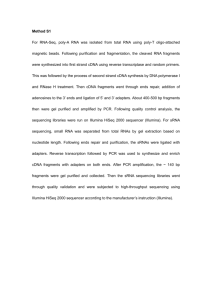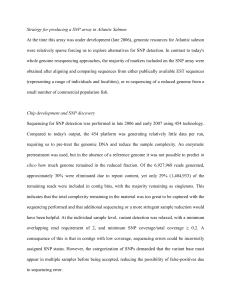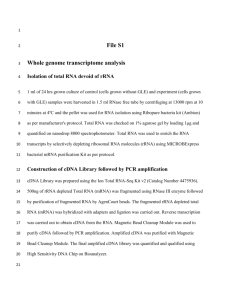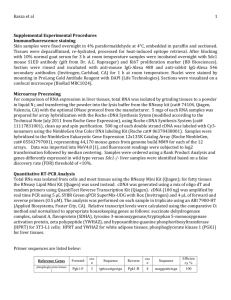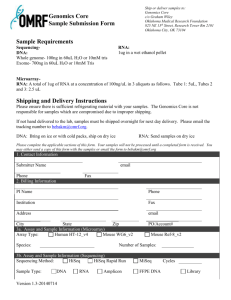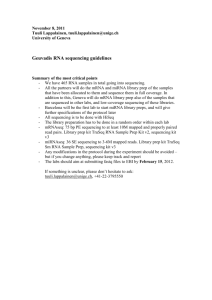Supplementary Information (docx 151K)
advertisement
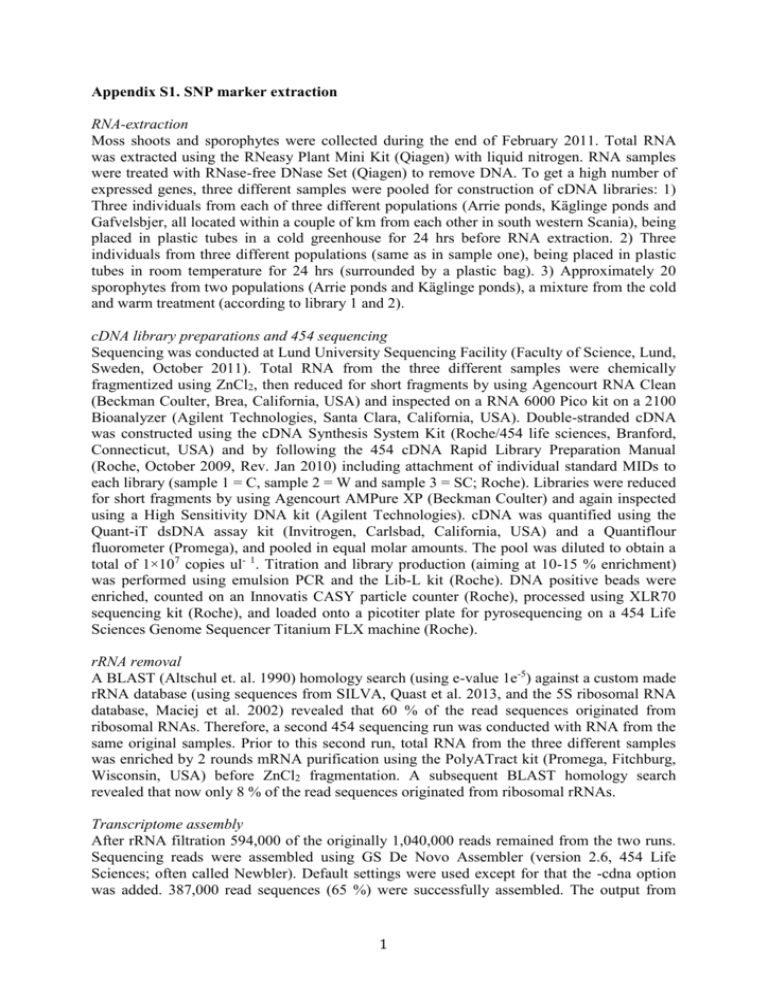
Appendix S1. SNP marker extraction RNA-extraction Moss shoots and sporophytes were collected during the end of February 2011. Total RNA was extracted using the RNeasy Plant Mini Kit (Qiagen) with liquid nitrogen. RNA samples were treated with RNase-free DNase Set (Qiagen) to remove DNA. To get a high number of expressed genes, three different samples were pooled for construction of cDNA libraries: 1) Three individuals from each of three different populations (Arrie ponds, Käglinge ponds and Gafvelsbjer, all located within a couple of km from each other in south western Scania), being placed in plastic tubes in a cold greenhouse for 24 hrs before RNA extraction. 2) Three individuals from three different populations (same as in sample one), being placed in plastic tubes in room temperature for 24 hrs (surrounded by a plastic bag). 3) Approximately 20 sporophytes from two populations (Arrie ponds and Käglinge ponds), a mixture from the cold and warm treatment (according to library 1 and 2). cDNA library preparations and 454 sequencing Sequencing was conducted at Lund University Sequencing Facility (Faculty of Science, Lund, Sweden, October 2011). Total RNA from the three different samples were chemically fragmentized using ZnCl2, then reduced for short fragments by using Agencourt RNA Clean (Beckman Coulter, Brea, California, USA) and inspected on a RNA 6000 Pico kit on a 2100 Bioanalyzer (Agilent Technologies, Santa Clara, California, USA). Double-stranded cDNA was constructed using the cDNA Synthesis System Kit (Roche/454 life sciences, Branford, Connecticut, USA) and by following the 454 cDNA Rapid Library Preparation Manual (Roche, October 2009, Rev. Jan 2010) including attachment of individual standard MIDs to each library (sample 1 = C, sample 2 = W and sample 3 = SC; Roche). Libraries were reduced for short fragments by using Agencourt AMPure XP (Beckman Coulter) and again inspected using a High Sensitivity DNA kit (Agilent Technologies). cDNA was quantified using the Quant-iT dsDNA assay kit (Invitrogen, Carlsbad, California, USA) and a Quantiflour fluorometer (Promega), and pooled in equal molar amounts. The pool was diluted to obtain a total of 1×107 copies ul‑ 1. Titration and library production (aiming at 10-15 % enrichment) was performed using emulsion PCR and the Lib-L kit (Roche). DNA positive beads were enriched, counted on an Innovatis CASY particle counter (Roche), processed using XLR70 sequencing kit (Roche), and loaded onto a picotiter plate for pyrosequencing on a 454 Life Sciences Genome Sequencer Titanium FLX machine (Roche). rRNA removal A BLAST (Altschul et. al. 1990) homology search (using e-value 1e-5) against a custom made rRNA database (using sequences from SILVA, Quast et al. 2013, and the 5S ribosomal RNA database, Maciej et al. 2002) revealed that 60 % of the read sequences originated from ribosomal RNAs. Therefore, a second 454 sequencing run was conducted with RNA from the same original samples. Prior to this second run, total RNA from the three different samples was enriched by 2 rounds mRNA purification using the PolyATract kit (Promega, Fitchburg, Wisconsin, USA) before ZnCl2 fragmentation. A subsequent BLAST homology search revealed that now only 8 % of the read sequences originated from ribosomal rRNAs. Transcriptome assembly After rRNA filtration 594,000 of the originally 1,040,000 reads remained from the two runs. Sequencing reads were assembled using GS De Novo Assembler (version 2.6, 454 Life Sciences; often called Newbler). Default settings were used except for that the -cdna option was added. 387,000 read sequences (65 %) were successfully assembled. The output from 1 runAssembly consists of (in Life Science vocabulary) isotigs or transcript variants. All isotigs with sequence lengths less than 30 nucleotides were removed. Since runAssembly produces flow based alignments, the read sequences were remapped to their isotig sequences with the alignment software Exonerate (version 2.2.0, Slate & Birney 2005) using the est2genome option. After these steps, a final number of 15,040 isotigs representing 369,075 reads (C: 138 013, W: 176 193, SC: 54 869) remained to be analysed. The average isotig length was 995 nucleotides. All isotigs are stored in an annotated database available at http://mioserv2.mbioekol.lu.se/Mosses/. SNP calling and filtering In our approach to study population genetics of H. lutescens we have chosen to use only single nucleotide polymorphisms (SNPs); in other words, insertions or deletions of nucleotides were deliberately avoided. The SNP calling was performed by a custom made Perl-program (available on request). In total 170,496 SNP positions were predicted. The SNPs were filtered using the following criteria: I: The less common allele (out of two alternative alleles in each SNP position) had a frequency of 19 % or higher. II: The read coverage of the SNP position was at least 26. III: There was zero (or at most one) adjacent SNP position within 60 nucleotides upstream or downstream of the targeted SNP position. The filtering resulted in 125 high quality SNPs. References Slater GS, Birney E (2005). Automated generation of heuristics for biological sequence comparison. BMC Bioinform 6: 31. Szymanski M, Barciszewska MZ, Erdmann VA, Barciszewski J (2002). 5S ribosomal RNA database. Nucleic Acids Res 30: 176-178. Quast C, Pruesse E, Yilmaz P, Gerken J, Schweer T, Yarza P, Peplies J, Glöckner FO (2013). The SILVA ribosomal RNA gene database project: improved data processing and webbased tools. Nucleic Acids Res 41: D590-D596. 2
